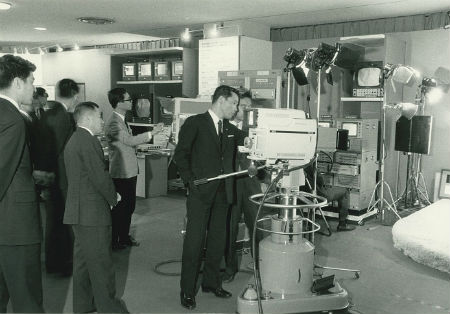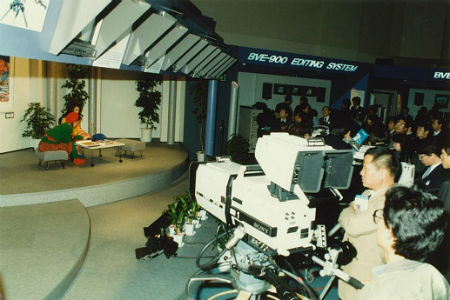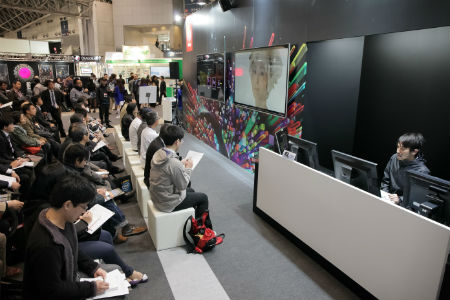
1964 Tokyo Olympics(The world’s first successful satellite broadcast)
In the autumn of 1964, called by the Japan Commercial Broadcasters Association, Inter BEE was launched with 12 exhibitors at the Invention Hall in Toranomon, Tokyo, as the parallel exhibit ‘The Broadcasting Equipment Exhibition” of the 2nd Technical Report Conference on Commercial Broadcasting.
The International Broadcast Equipment Exhibition
The second exhibition (1966) was a joint exhibition between the Japan Commercial Broadcasters Association and the Electronic Industry Association (currently known as the Japan Electronics and Information Technology Industries Association/JEITA). From the third exhibition (1967), the venue was moved to the Science Museum located in Kitanomaru, Tokyo, which had just opened at the time. The fourth exhibition (1963) was held under the main sponsorship of the Electronic Industry Association with the NAB-J as a supporting organization.
1969 Apollo 11 moon landing (Live satellite broadcast watched by 600 million worldwide)
And from the tenth exhibition in 1974, the Japan Broadcasting Corporation (NHK) also became a cooperating organization. Established specifically for the benefit of broadcast equipment users, the exhibition garnered much attention within the industry to earn it a prominent position among domestic exhibitions.
The eleventh exhibition in 1975 attracted a remarkable amount of attention when an experimental display called, “Broadcast-TV Multiplex Broadcasts? The Wave of the Future”, was created as a special exhibit. The number of visitors and exhibitors increased significantly from the thirteenth exhibition in 1977 and by the fourteenth exhibition in 1978, the number of overseas exhibits grew to coincide with the rising amount of international visitors.
1977 Sadaharu O world record home run
The venue for the eighteenth exhibition in 1982 was moved to the TRC (Tokyo Ryutsu Center) in Heiwajima, Tokyo, which offered 2.5 times more exhibition space than the Science Museum. Taking advantage of this move, the exhibition name was changed to “The International Broadcast Equipment Exhibition (Inter BEE)”, to reflect the growing number of participants from overseas. Sections within the exhibition become more specialized and were clearly grouped into different categories such as Professional Audio, Broadcast Equipment-Materials, and Camera/VTR/Studio Equipment. This helped provide participants with unfettered access to an expanding range of fields to better answer the needs of broadcast stations, software producers, CATV, and public organizations, as well as companies seeking to purchase new broadcast equipment.
In 1985, the twenty-first exhibition was relocated to the Convention Center Tokyo at Ikebukuro Sunshine City, which expanded exhibition space to 13,000 square meters. Moreover, the exhibition was now recognized both in Japan and overseas as a truly international event that included exhibitors from over 250 companies. This period also marked the beginning of a series of new services such as the publication of a broadcast equipment catalog, the holding of international symposiums, and a system for full visitor registration.

1989 From Showa to Heisei
The venue of the twenty-sixth exhibition in 1990 was relocated to its current site at Makuhari Messe with an initial exhibition space of 20,000 square meters. Since then, a new exhibition hall has been added about once every five years to expand exhibition space. More than 30,000 visitors attended the thirty-fourth exhibition in 1998, with the event now ranking alongside the NAB in the USA and the IBC in Europe as one of the top exhibitions in the broadcast equipment field. The number of visitors exceeded 30,000 from the thirty-fourth exhibition in 1993, with the event now ranking alongside the NAB in the USA and the IBC in Europe as one of the top exhibitions in the broadcast equipment field.
2000 The launch of BS digital broadcast
From the thirty-sixth exhibition in 2000, the process of digitalization of broadcasting, starting with broadcasting satellites, brought about great changes in the broadcasting industry. Numerous proposals for digital equipment began to surface, producing an immense effect on the creation of peripheral industries and new business opportunities as well as the broadcasting industry itself.
2002 Japan-Korea FIFA World Cup
2003 The launch of terrestrial digital broadcasting (in three major metropolitan areas)
2006 The launch of one-segment broadcasting
For the forty-third exhibition in 2007, the name of the event was published as “Inter BEE” in a move meant to attract media outside of broadcasting. “Inter BEE online” was set up to reach a broader audience via the website, and exhibit information and news was presented in news articles and in video format.
For the forty-fourth exhibition in 2008, a professional lighting division was added. This expansion provided an opportunity for imaging and lighting collaboration, and broadened the possibilities for exhibition. More than 35,000 visitors attended the exhibition, which garnered interest from the broadcasting industry and many other types of media.
In the forty-fifth exhibition in 2009, the number of exhibitors for the first time exceeded 800 companies.
In its forty-sixth year, the exhibition began to feature a different country or region each time, beginning with Korea in 2010, to actively approach the Asian market, and to reinforce its global measures.
2011 The discontinuation of terrestrial analogue broadcasting (excluding three prefectures in Tohoku)
For the forty-seventh exhibition in 2011, with the transition to terrestrial digital broadcasting complete (except in the three prefectures in north-eastern Japan), a new cross media division was established to consolidate proposals for new media using no longer used bandwidth and businesses other than digital content broadcasting. The organization moved forward with the new goal of becoming a comprehensive media exhibition incorporating IPTV, Mobile TV, digital signage, digital cinema, 3D and digital content.
The International Broadcast Equipment Exhibition
2014 Channel 4K test broadcast
To mark the fiftieth year of the exhibition, Inter BEE is planning a variety of anniversary events, as well as new events. Such active efforts have expanded the exhibition to include six exhibition halls (five last year), in addition to the Makuhari Messe event hall.
Inter BEE continues to respond to the needs of professionals in the field. By incorporating both Japanese and international markets, the exhibition has become a steady channel of industry information to its target audience. For exhibitors and visitors alike, Inter BEE continues to be a forum for effective exchange of meaningful information and the creation of business opportunities.
Further growth can be expected of Inter BEE as a comprehensive media exhibition.
2016 8K test broadcasting
2020 Tokyo Olympics










